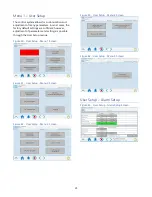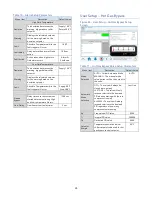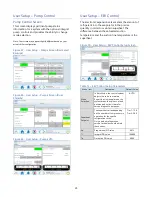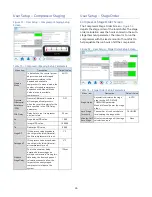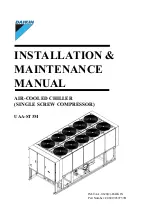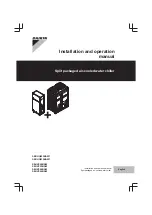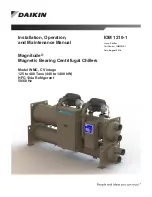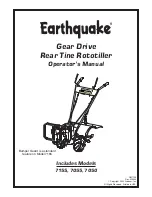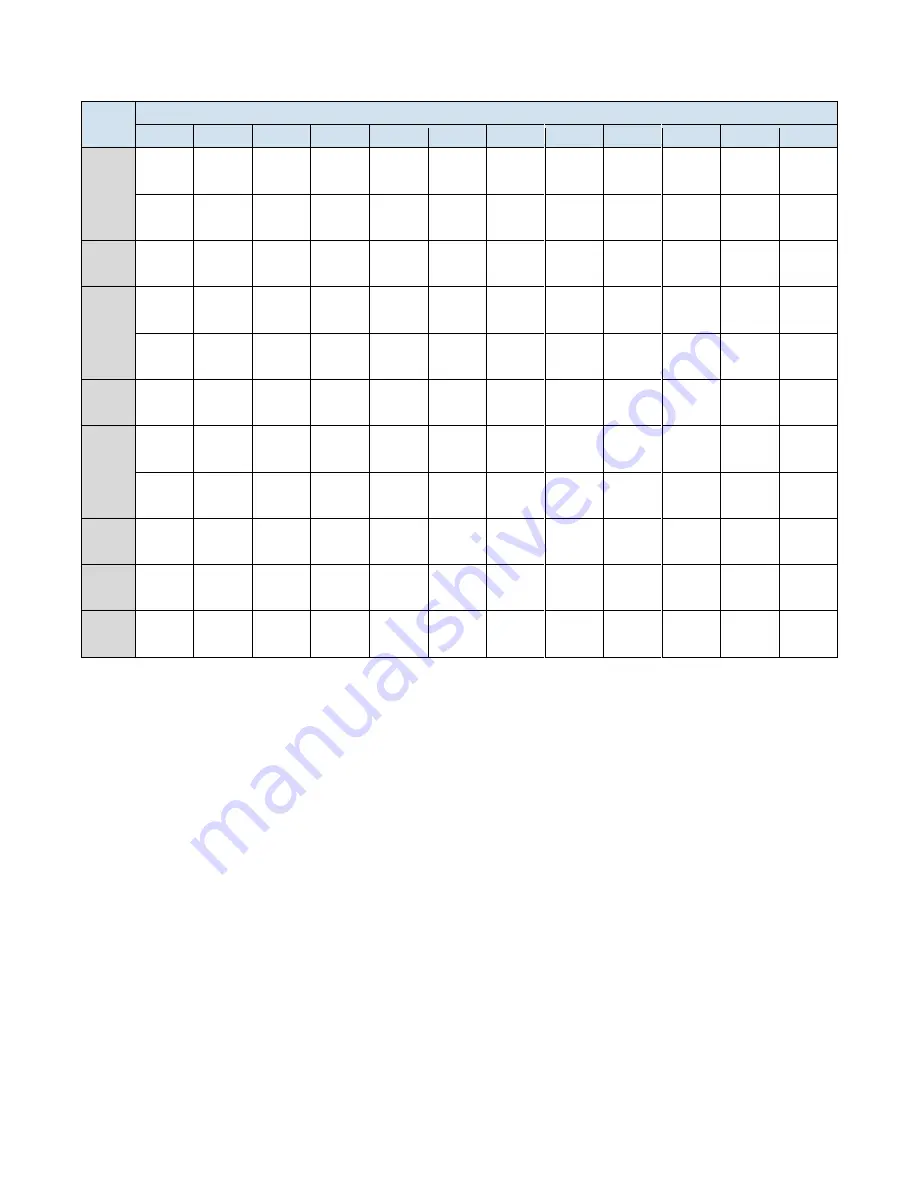
12
Table 5 - Upflow Discharge Line Sizes for R410A (inches OD)
Circuit
Tons
Total Equivalent Length (Ft)
25
50
75
100
125
150
175
200
225
250
275
300
10
A – 3/8 A – 3/8
A – 3/8
A – 3/8 A – 3/8 A – 3/8 A – 3/8 A – 3/8 A – 3/8 A – 3/8 A – 3/8 A – 3/8
B – 3/4
B – 3/4
B – 3/4
B – 3/4
B – 3/4
B – 3/4
B – 3/4
B – 7/8
B – 7/8
B – 7/8
B – 7/8
B – 7/8
15
A -
⅜
A – 3/8
A – 3/8
A – 3/8 A – 3/8 A – 3/8 A – 3/8 A – 3/8 A – 3/8 A – 3/8 A – 1/2 A – 1/2
B – 3/4
B – 3/4
B – 7/8
B – 7/8
B – 7/8
B – 7/8
B – 7/8
B – 7/8
B – 7/8
B – 7/8 B – 1 1/8 B – 1 1/8
20
A – 3/8 A – 3/8
A – 3/8
A – 1/2 A – 1/2 A – 1/2 A – 1/2 A – 1/2 A – 1/2 A – 1/2 A – 5/8 A – 5/8
B – 3/4
B – 7/8
B – 7/8 B – 1 1/8 B – 1 1/8 B – 1 1/8 B – 1 1/8 B – 1 1/8 B – 1 1/8 B – 1 1/8 B – 1 3/8 B – 1 3/8
25
A – 3/8 A – 3/8
A – 3/8
A – 1/2 A – 1/2 A – 1/2 A – 1/2 A – 1/2 A – 1/2 A – 1/2 A – 5/8 A – 5/8
B – 7/8
B – 7/8
B – 7/8 B – 1 1/8 B – 1 1/8 B – 1 1/8 B – 1 1/8 B – 1 1/8 B – 1 1/8 B – 1 1/8 B – 1 3/8 B – 1 3/8
30
A – 1/2 A – 1/2
A – 1/2
A – 3/4 A – 3/4 A – 3/4 A – 3/4 A – 3/4 A – 3/4 A – 3/4 A – 3/4 A – 3/4
B – 7/8
B – 7/8
B – 7/8 B – 1 1/8 B – 1 1/8 B – 1 1/8 B – 1 1/8 B – 1 1/8 B – 1 1/8 B – 1 3/8 B – 1 3/8 B – 1 3/8
40
A – 3/4 A – 3/4
A – 3/4
A – 3/4 A – 3/4 A – 3/4 A – 3/4 A – 3/4 A – 3/4 A – 3/4 A – 3/4 A – 3/4
B – 1 3/8 B – 1 3/8 B – 1 3/8 B – 1 3/8 B – 1 3/8 B – 1 3/8 B – 1 5/8 B – 1 5/8 B – 1 5/8 B – 1 5/8 B – 1 5/8 B – 1 5/8
50
A – 3/4 A – 3/4
A – 3/4
A – 3/4 A – 3/4 A – 3/4 A – 3/4 A – 3/4 A – 3/4 A – 3/4 A – 3/4 A – 3/4
B – 1 3/8 B – 1 3/8 B – 1 3/8 B – 1 3/8 B – 1 3/8 B – 1 5/8 B – 1 5/8 B – 1 5/8 B – 1 5/8 B – 1 5/8 B – 1 5/8 B – 1 5/8
60
A – 3/4 A – 3/4
A – 7/8
A – 7/8 A – 7/8 A – 7/8 A – 7/8 A – 7/8 A – 7/8 A – 7/8 A – 7/8 A – 7/8
B – 1 3/8 B – 1 3/8 B – 1 5/8 B – 1 5/8 B – 1 5/8 B – 1 5/8 B – 1 5/8 B – 1 5/8 B – 1 5/8 B – 1 5/8 B – 1 5/8 B – 1 5/8
80
A – 3/4 A – 3/4
A – 7/8
A – 7/8 A – 7/8 A – 7/8 A – 7/8 A – 7/8 A – 7/8 A – 7/8 A – 7/8 A – 7/8
B – 1 3/8 B – 1 3/8 B – 1 5/8 B – 1 5/8 B – 1 5/8 B – 1 5/8 B – 1 5/8 B – 1 5/8 B – 2 1/8 B – 2 1/8 B – 2 1/8 B – 2 1/8
100
A – 1 1/8 A – 1 1/8 A – 1 1/8 A – 1 3/8 A – 1 3/8 A – 1 3/8 A – 1 3/8 A – 1 3/8 A – 1 3/8 A – 1 5/8 A – 1 5/8 A – 1 5/8
B – 2 1/8 B – 2 1/8 B – 2 1/8 B – 2 1/8 B – 2 5/8 B – 2 5/8 B – 2 5/8 B – 2 5/8 B – 2 5/8 B – 2 1/8 B – 2 1/8 B – 2 1/8
120
A – 1 1/8 A – 1 1/8 A – 1 1/8 A – 1 3/8 A – 1 3/8 A – 1 3/8 A – 1 3/8 A – 1 3/8 A – 1 3/8 A – 1 5/8 A – 1 5/8 A – 1 5/8
B – 1 5/8 B – 1 5/8 B – 2 1/8 B – 2 5/8 B – 2 5/8 B – 2 5/8 B – 2 5/8 B – 2 5/8 B – 2 5/8 B – 2 5/8 B – 2 5/8 B – 2 5/8
Calculating Refrigerant and Oil Charge
To determine the approximate charge, first refer to
Table 6 and establish the required charge for the
condenser and chiller. Then refer to Table 7 to
determine the charge required for the field-installed
piping per circuit. The approximate charge per circuit
is therefore the sum of the values from Table 6 and
The charge required for an air-cooled condenser
using fan cycling and variable speed for head
pressure control is indeterminate due to site and
environmental variances. Because refrigerant density
increases with decreasing temperatures, the low
ambient operating charge is more (compared to the
summer charge). In the worst case of -20°F, the
charge may nearly double. The best way to assure
proper charging is, on the coldest day of the year
under full load, the charge should be up to the
second sight glass from the bottom of the receiver
with the electric expansion valve (EXV) sight glass
clear. Prolonged periods of foaming in the sight
glass may indicate a low refrigerant condition or a
restriction in the liquid line.
Note: Occasional bubbling in a sight glass may occur at a time
when load conditions are changing and the expansion valve is
adjusting to the new conditions. This momentary occurrence is a
result of normal chiller operation.
Use the sight glass to check if there is moisture in
the refrigeration circuit. If there is moisture in the
circuit, the green ring around the perimeter of the
sight glass will turn yellow. If this occurs, service
immediately.


























